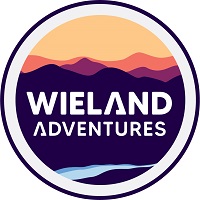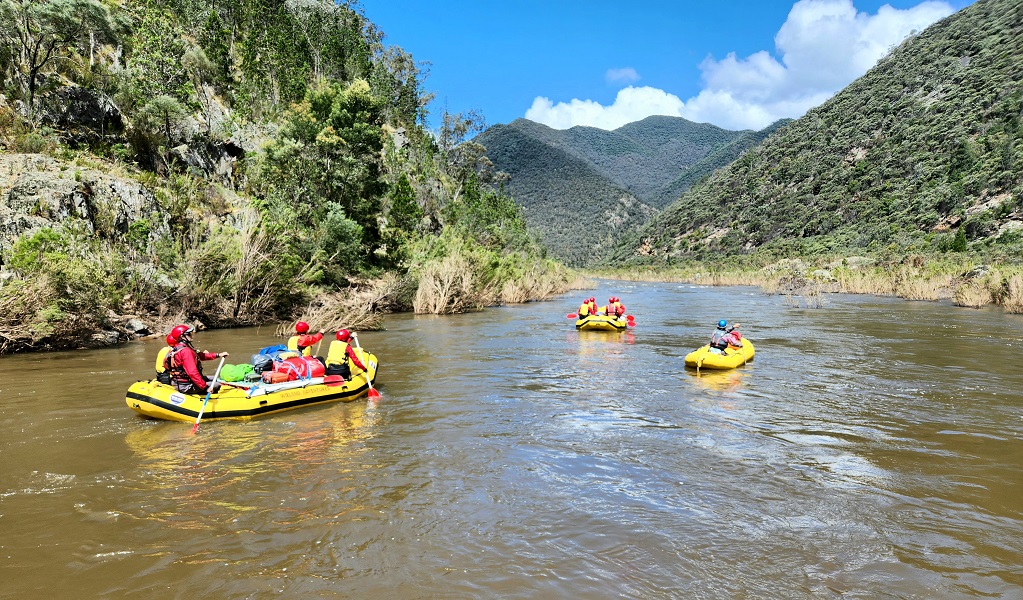Snowy River whitewater adventure tours
Lower Snowy River area in Kosciuszko National Park
Overview
Paddle down the famed Snowy River on a guided tour with Wieland Adventures. These whitewater rafting expeditions are a thrilling way to explore this remote corner of Kosciuszko National Park.
- When
Contact Wieland Adventures for tour dates.
- Where
- Lower Snowy River area
- Accessibility
- No wheelchair access
- Grade
- Medium. A moderate level of fitness is required for this tour. Suitable for adults and children 12 years and older. All children must be accompanied by a supervising adult.
- Price
-
Contact Wieland Adventures for pricing.
- Entry fees
- Price includes park entry fee
- Equipment
provided - Yes
- Bookings
- Bookings required. Book online or email or call Wieland Adventures on 0421 162 584.
- Availability
- Available on request. Contact Wieland Adventures for more information.
Join experienced guides from Wieland Adventures for an action-packed day of whitewater rafting in Kosciuszko National Park. Enjoy impressive mountain scenery as you journey along the spectacular waterways of the famous Snowy River.
Choose an experience to suit your own pace. Enjoy tranquil paddling over pristine waterways and take in the rugged beauty of Australia’s alpine region. If you’re seeking an adventure, you can experience the thrill of taking on exciting river rapids. Join an existing small group tour or talk to the team at Wieland Adventures to tailor an experience for your group.
Wieland Adventures is a family owned and operated business with years of experience in running safe and environmentally responsible adventures in remote locations. You’ll be in safe hands with their experienced guides and state of the art safety systems. They will provide all the equipment you need for a safe and enjoyable experience.
Wieland adventures also offer horse riding, hiking, rock climbing, abseiling and fishing experiences in the Snowy Mountains region.
Wieland Adventures is a licensed commercial tour operator with a Parks Eco Pass.
Local alerts
For the latest updates on fires, closures and other alerts in this area, see https://www.nationalparks.nsw.gov.au/things-to-do/guided-tours/snowy-river-whitewater-adventure-tours/local-alerts
Operated by

Park info
- in the Lower Snowy River area of Kosciuszko National Park in the Snowy Mountains region
The Lower Snowy River area is open all year, but some roads and trails may close due to weather conditions or park management issues.
-
No park entry fees apply in the Lower Snowy River area. See vehicle entry fees for other areas in Kosciuszko National Park.
Buy annual pass.
Visitor info
All the practical information you need to know about Snowy River whitewater adventure tours.
Maps and downloads
Visitor centre
-
Snowy Region Visitor Centre
49 Kosciuszko Road, Jindabyne NSW 2627 - 8.30am to 5pm daily. Closed Christmas Day.
- 02 6450 5600
Learn more
Snowy River whitewater adventure tours is in Lower Snowy River area. Here are just some of the reasons why this park is special:
A sanctuary for wildlife

The Lower Snowy River is a haven for plants and animals, including rare species. While kangaroos, swamp wallabies and wombats are common, keep an eye out for the endangered spotted-tailed quoll, shy platypus, short-beaked echidna, and impressive wedge-tailed eagles. White box and cypress pine are common in the dry woodlands, as are grass trees - ancient flowering plants that have existed since dinosaurs roamed Australia.
Drive the old drovers route

In the 1800s, Lower Snowy drive (Barry Way) formed the stock route for sheep and cattle travelling from summer grazing, in the high alpine country, to Bairnsdale markets. The eagle-eyed can spot tree markers and the remains of old stockyards near Jacobs River campground. Before federation, a customs house stood at Willis picnic area, for the Victorian Government to collect taxes on cattle crossing the border.
- Lower Snowy drive (Barry Way) Lower Snowy drive is a sprawling road trip that takes travellers past picnic spots, swimming holes, campgrounds and lookouts in the Snowy River valley.
World-class wilderness

In recognition of Kosciuszko's unique value as a conservation area, it’s been named a UNESCO Biosphere Reserve. More than half of the park, over 350,000ha (almost 865,000 acres), has been declared wilderness, including Pilot Wilderness and Byadbo Wilderness in the Lower Snowy River area. Pilot Wilderness, which rises from just over 200m in the Lower Snowy River valley to 1830m at The Pilot mountain, makes up over 20 per cent of this protected area.
- Pilot Wilderness mountain bike ride (Alpine Way to Barry Way) Pilot Wilderness mountain bike ride in Kosciuszko National Park is a challenging, long-distance mountain bike trail that is suited to experienced mountain bike riders.
- Snowy River whitewater adventure tours Paddle down the famed Snowy River on a guided tour with Wieland Adventures. These whitewater rafting expeditions are a thrilling way to explore this remote corner of Kosciuszko National Park.
- Snowy River wilderness experience Paddle the iconic Snowy River on a 5-day adventure in remote Kosciuszko National Park. Camp in Byadbo Wilderness with your Aboriginal guide on this unforgettable experience.
Plants and animals protected in this park
Animals
-

Yellow-tailed black cockatoo (Calyptorhynchus funereus)
The yellow-tailed black cockatoo is one of the largest species of parrot. With dusty-black plumage, they have a yellow tail and cheek patch. They’re easily spotted while bird watching, as they feed on seeds in native forests and pine plantations.
-

Wedge-tailed eagle (Aquila audax)
With a wingspan of up to 2.5m, the wedge-tailed eagle is Australia’s largest bird of prey. These Australian animals are found in woodlands across NSW, and have the ability to soar to heights of over 2km. If you’re bird watching, look out for the distinctive diamond-shaped tail of the eagle.
-

Emu (Dromaius novaehollandiae)
The largest of Australian birds, the emu stands up to 2m high and is the second largest bird in the world, after the ostrich. Emus live in pairs or family groups. The male emu incubates and rears the young, which will stay with the adult emus for up to 2 years.
-

Swamp wallaby (Wallabia bicolor)
The swamp wallaby, also known as the black wallaby or black pademelon, lives in the dense understorey of rainforests, woodlands and dry sclerophyll forest along eastern Australia. This unique Australian macropod has a dark black-grey coat with a distinctive light-coloured cheek stripe.
-

Platypus (Ornithorhynchus anatinus)
One of the most fascinating and unusual Australian animals, the duck-billed platypus, along with the echidna, are the only known monotremes, or egg-laying mammals, in existence. The platypus is generally found in permanent river systems and lakes in southern and eastern NSW and east and west of the Great Dividing Range.
-

Short-beaked echidna (Tachyglossus aculeatus)
One of only 2 egg-laying mammals in the world, the short-beaked echidna is one of the most widespread of Australian native animals. Covered in spines, or quills, they’re equipped with a keen sense of smell and a tube-like snout which they use to break apart termite mounds in search of ants.
-

Tawny frogmouth (Podargus strigoides)
Found throughout Australia, the tawny frogmouth is often mistaken for an owl due to its wide, powerful beak, large head and nocturnal hunting habits. The ‘oom oom oom’ call of this native bird can be heard echoing throughout a range of habitats including heath, woodlands and urban areas.
-

Common brushtail possum (Trichosurus vulpecula)
One of the most widespread of Australian tree-dwelling marsupials, the common brushtail possum is found across most of NSW in woodlands, rainforests and urban areas. With strong claws, a prehensile tail and opposable digits, these native Australian animals are well-adapted for life amongst the trees.
-

Bare-nosed wombat (Vombatus ursinus)
A large, squat marsupial, the Australian bare-nosed wombat is a burrowing mammal found in coastal forests and mountain ranges across NSW and Victoria. The only other remaining species of wombat in NSW, the endangered southern hairy-nosed wombat, was considered extinct until relatively recently.
-

Superb lyrebird (Menura novaehollandiae)
With a complex mimicking call and an elaborate courtship dance to match, the superb lyrebird is one of the most spectacular Australian animals. A bird watching must-see, the superb lyrebird can be found in rainforests and wet woodlands across eastern NSW and Victoria.
-

Spotted-tailed quoll (Dasyurus maculatus)
The spotted-tailed quoll is the largest remaining carnivorous marsupial on the Australian mainland. It’s protected as a vulnerable species in NSW.
Plants
-

Grass tree (Xanthorrea spp.)
An iconic part of the Australian landscape, the grass tree is widespread across eastern NSW. These Australian native plants have a thick fire-blackened trunk and long spiked leaves. They are found in heath and open forests across eastern NSW. The grass tree grows 1-5m in height and produces striking white-flowered spikes which grow up to 1m long.
-

Old man banksia (Banksia serrata)
Hardy Australian native plants, old man banksias can be found along the coast, and in the dry sclerophyll forests and sandstone mountain ranges of NSW. With roughened bark and gnarled limbs, they produce a distinctive cylindrical yellow-green banksia flower which blossoms from summer to early autumn.
-

Scribbly gum (Eucalyptus haemastoma)
Easily identifiable Australian native plants, scribbly gum trees are found throughout NSW coastal plains and hills in the Sydney region. The most distinctive features of this eucalypt are the ‘scribbles’ made by moth larva as it tunnels between the layers of bark.

